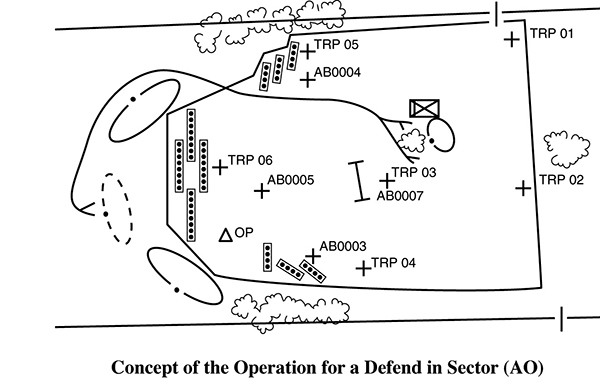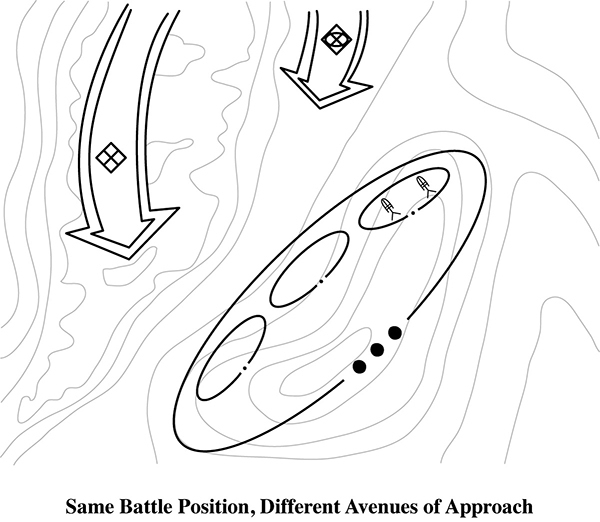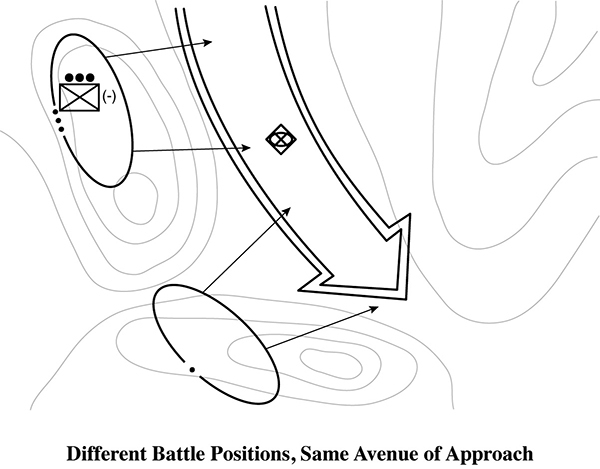Leaders control fires using standard commands, pyrotechnics, and other prearranged signals. The platoon increases the intensity of fires as the enemy closes within range of additional weapons. Squad leaders work to achieve a sustained rate of fire from their positions by having buddy teams fire their weapons so that both are not reloading at the same time. In controlling and distributing fires, the platoon and squad leaders consider:
•Range to the enemy.
•Priority targets (what to fire at, when to fire, and why).
•Nearest or most dangerous targets.
•Shifting to concentrate fires on their own initiative or as directed by higher headquarters.
•Ability of the platoon to engage dismounted enemy with enfilading, grazing fires.
•Ability of the platoon’s antiarmor weapons to achieve flank shots against enemy vehicles.
As the enemy closes on the platoon’s protective wire, the platoon leader initiates FPFs:
•Machine guns and automatic weapons fire along interlocking PDFs or FPLs as previously designated and planned. Other weapons fire at designated PDFs. M203 grenade launchers engage the enemy in dead space or against enemy attempts to breach protective wire.
•The platoon continues to fight with Claymores and hand grenades.
•If applicable, the platoon leader requests indirect FPFs if they have been assigned in support of his positions.
The platoon continues to defend until the enemy is repelled or the platoon is ordered to disengage.
If the platoon cannot stop or destroy the enemy from its current position, the platoon leader reports the situation to the company commander and continues to engage the enemy or repositions the platoon (or squads). In this situation—and when directed by the company commander—the platoon leader may:
•Continue fires into the platoon sector (engagement area).
•Occupy supplementary positions.
•Reinforce other parts of the company.
•Counterattack locally to retake lost fighting positions.
•Withdraw from an untenable position using fire and movement to break contact. (The platoon leader will not be ordered to move his platoon out of position if it will destroy the integrity of the company defense.)
Note: In any movement out of a defensive position, the platoon must employ all direct and indirect fire means available to suppress the enemy long enough for the unit to move.
DEFENSIVE TECHNIQUES
The company commander’s analysis will determine the most effective manner in which to defend. He will direct the platoons in what defensive techniques to employ. The platoon normally will defend using one of these basic techniques:
1.Defend in sector or area of operation (AO).
2.Defend a battle position (BP).
3.Defend a strongpoint.
4.Defend a perimeter.
5.Defend a reverse slope.
Defend in Sector/Area of Operation
Defending an area allows a unit to maintain flank contact and security, affords depth in the platoon defense, and facilitates clearance of supporting fires. Area/sector defense is used when flexibility is desired; when retention of specific terrain features is not necessary; or when the unit cannot concentrate fires because of extended frontages, intervening terrain features, and/or multiple avenues of approach. The platoon is assigned an AO defense mission to prevent a specific number of enemy forces from penetrating the rear boundary of the AO. To maintain the integrity of the AO defense, the platoon must remain tied to adjacent units on the flanks. The company commander may direct the platoon to conduct the defense in one of two ways:
1.He may specify a series of subsequent defensive positions within the AO from which the platoon will defend to ensure that the fires of two platoons can be massed.
2.He may assign an AO to the platoon. The platoon leader assumes responsibility for most tactical decisions and controlling maneuvers of his subordinate squads by assigning them a series of subsequent defensive positions in accordance with guidance from the company commander in the form of intent, specified tasks, and the concept of the operation. The company commander normally assigns an AO to a platoon only when it is fighting in isolation.

Defend a Battle Position
The company commander assigns the defend a battle position defensive technique to his platoons when he wants to mass the fires of two or more platoons in a company EA or to position a platoon to execute a counterattack. A unit defends from a BP to destroy an enemy force in the EA, block an enemy avenue of approach, control key or decisive terrain, and/or fix the enemy force to allow another unit to maneuver. The company commander designates EAs to allow each platoon to concentrate its fires or to place it in an advantageous position for the counterattack.
BPs are developed in such a manner to provide the platoon the ability to place direct fire throughout the EA. The size of the platoon BP can vary, but it should provide enough depth and maneuver space for subordinate squads to maneuver into alternate or supplementary positions and to counterattack. The BP is a general position on the ground. The platoon leader places his squads on the most favorable terrain in the BP, based on the higher unit mission and commander’s intent. The platoon then fights to retain the position unless ordered by the company commander to counterattack or displace. The basic methods of employing a platoon in a BP are:
•Same BP, same avenue of approach.
•Same BP, different avenues of approach.
•Different BPs, same avenue of approach.
•Different BPs, different avenues of approach.
Same Battle Position, Same Avenue of Approach. Rifle squads are on the same BP, covering the same avenue of approach. The platoon can defend against mounted and dismounted attacks and move rapidly to another position. All squads are in the same BP when the terrain provides good observation, fields of fire, and cover and concealment.
Employing all the squads of the platoon on the same BP and covering the same avenue of approach is the most conservative use of the platoon. It has two primary advantages: It facilitates C2 functions because of the proximity of squad elements on the same approach, and it provides increased security.
Same Battle Position, Different Avenues of Approach. Rifle squads occupy the same BP but cover different enemy avenues of approach. Try to choose BPs that will cover multiple avenues of approach or require minimum movement.
Different Battle Positions, Same Avenue of Approach. Rifle squads are on different BPs, covering the same avenue of approach. If positioned on separate BPs, rifle squads must fight in relation to each other when covering the same avenues of approach. A weapons squad can provide supporting fires for the rifle squads from their primary, alternate, or supplementary positions. All squads are positioned to engage enemy forces on the same avenue of approach but at different ranges.




Different Battle Positions, Different Avenues of Approach. Squads may be employed on different BPs and different avenues of approach. Take caution in planning to ensure that the squad BPs cannot be either fixed or isolated and defeated by the enemy.